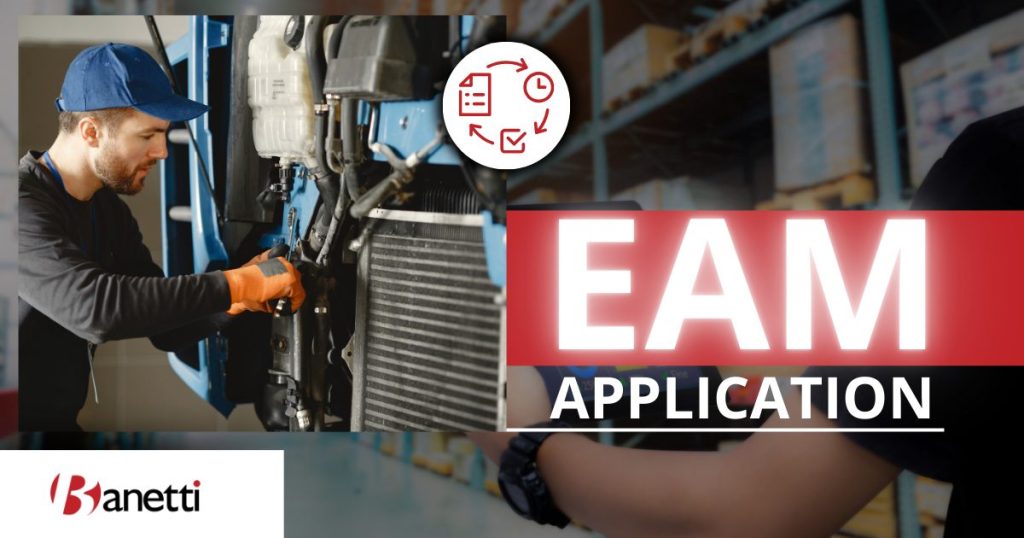5 Min Read
Table of contents

Enterprise Asset Management (EAM) applications have become the backbone of asset-intensive industries, enabling organizations to manage, monitor, and optimize their physical assets across the entire asset lifecycle. From fleet maintenance and fuel management to linear assets like pipelines and railways, modern EAM software is designed to ensure higher asset reliability, reduced operational costs, and maximum asset uptime.
What Is an EAM Application?

An EAM application is a strategic platform that integrates enterprise asset management systems, processes, and tools to maintain and control critical assets such as plants, machinery, mobile assets, and infrastructure.
Unlike a computerized maintenance management system (CMMS), which focuses primarily on maintenance operations, an EAM system provides end-to-end asset lifecycle management, including planning, acquisition, maintenance, and eventual disposal.
Purpose
The purpose of an enterprise asset management (EAM) application is to increase asset utilization, improve asset performance, and extend asset life. It supports preventive maintenance and predictive maintenance strategies, enabling organizations to minimize downtime, control maintenance costs, and deliver accurate operational insights.
Key Features of an EAM Application

An EAM system provides a wide range of capabilities that make it indispensable to asset-intensive organizations.
Asset Lifecycle Management
EAM software provides structured oversight from acquisition to retirement. Organizations can track asset information, schedule maintenance procedures, and optimize business processes to improve overall asset quality.
Preventive & Predictive Maintenance
Through preventive maintenance schedules and predictive maintenance analytics, an EAM system can anticipate failures before they happen. With real-time data from IoT sensors and diagnostic tools, companies reduce asset downtime and create more effective maintenance processes.
Work Order Management
EAM applications streamline maintenance work by creating, assigning, and tracking initial requests through to completion. Teams benefit from improved labor efficiency and fewer bottlenecks in maintenance operations.
Inventory & Spare Parts Management
Managing inventory costs is vital. EAM platforms centralize spare parts, automate reordering, and align with supply chain management systems to ensure equipment maintenance procedures aren’t delayed by missing stock.
Vendor & Contract Management
Organizations can use EAM to oversee service contracts, evaluate vendor performance, and manage costs related to maintenance operations and third-party suppliers.
Reporting & Dashboards
Modern EAM software integrates analytical and diagnostic tools, advanced analytics, and artificial intelligence for continuous asset data monitoring. This supports business intelligence reporting, risk management, and proactive process change management.
Integrations
Modern EAM applications integrate with ERP systems, cloud software, mobile apps, IoT devices, GIS, and supply chain management systems. These integrations allow organizations to unify business processes, gather asset data from multiple sources, and deliver real-time data insights.
Benefits of Using an EAM Application

An EAM system offers measurable advantages across industries.
Reduce unplanned downtime
By adopting preventive maintenance schedules and accurate alerts, businesses keep critical assets running, reducing losses from unexpected failures.
Extend asset life
With structured asset lifecycle practices, organizations manage aging assets more effectively, improving asset reliability and ensuring higher ROI.
Lower maintenance costs
Through streamlined maintenance procedures, optimized parts management, and better labor efficiency, EAM reduces overheads while increasing output.
Ensure safety and compliance
Built-in risk management and process change management features reduce safety incidents, improve audits, and ensure compliance with regulations.
Enable data-driven decisions
Collecting data from sensors and applying advanced analytics or artificial intelligence empowers organizations to take proactive action with greater accuracy.
Improve field service efficiency
Mobile-enabled EAM applications help technicians track asset data, monitor equipment readiness, and complete maintenance work faster while ensuring minimal downtime.
Who Uses EAM Applications?

EAM systems are not just for maintenance teams; they also serve a broad set of industries and roles.
Industries
Enterprise asset management software is most critical in asset-intensive industries such as manufacturing, utilities, energy, transportation, and public infrastructure. These sectors rely on EAM to manage linear assets like pipelines, railways, and power lines, as well as complex facilities and fleets.
By leveraging asset lifecycle management, predictive maintenance, and advanced analytics, organizations in these industries can reduce operational costs, ensure asset availability, and extend the life of both new and aging assets while staying compliant with safety and environmental regulations.
Roles
An EAM application is used by a diverse set of stakeholders within an organization. Maintenance teams depend on it for managing maintenance work, scheduling preventive maintenance schedules, and minimizing asset downtime. Asset managers leverage asset data and dashboards to track performance, maximize asset utilization, and control maintenance costs.
Finance leaders use EAM to monitor inventory costs, optimize financial management, and align with compliance standards, while operations executives depend on it to improve equipment readiness, oversee business processes, and ensure that enterprise assets continue to deliver reliable performance.
Choosing the Right EAM Application

Selecting the best asset management software depends on organizational needs and goals.
Scalability for Multi-Site Operations
Organizations with multiple plants or facilities need a scalable EAM platform to manage enterprise assets across geographies with unified asset information.
Cloud vs On-Premises Deployment
Cloud software provides real-time data, automatic updates, and flexible pricing. On-premises offers more control but often higher operational costs.
Ease of Use and Mobile Support
Modern systems must be intuitive and support field teams with mobile assets tracking, fleet maintenance, and offline maintenance work access.
Integration Capabilities
The ability to connect with ERP, supply chain, and business processes ensures that EAM remains a single technology system for all asset-related functions.
Licensing and Total Cost of Ownership
Costs extend beyond licenses—organizations must evaluate inventory costs, maintenance operations, and long-term financial management.
Popular EAM Applications in 2025

The EAM market is highly competitive, with several vendors offering specialized platforms.
IBM Maximo® Application Suite
A leading enterprise asset management software, IBM Maximo® provides robust asset tracking, predictive maintenance, and advanced analytics. Its single technology system integrates AI and IoT for operational efficiency and risk management.
SAP EAM
SAP’s solution integrates tightly with supply chain management systems and business processes, offering powerful data management tools, asset data insights, and comprehensive asset lifecycle management.
Oracle eAM
Oracle focuses on asset-intensive organizations with strong fleet maintenance, fuel management, and financial management features. It is widely used in industries like energy and utilities.
IFS Cloud
IFS offers a flexible cloud-native EAM platform supporting mobile assets, equipment maintenance, and linear assets, helping companies reduce operational costs while improving asset utilization.
HxGN EAM (Hexagon)
Strong in asset-intensive industries, HxGN EAM specializes in infrastructure and linear assets, delivering diagnostic and analytical tools for utilities, railways, and energy.
Ultimo EAM
Ultimo delivers AI-augmented EAM software that enhances maintenance processes, reduces maintenance costs, and improves asset uptime. Its user-friendly design and quick ROI make it attractive for mid-market organizations.
Conclusion
An EAM application is more than just a tool for maintenance management. It is the foundation of modern asset management systems, unifying data management, supply chain oversight, and operational insights. By leveraging real-time data, artificial intelligence, and predictive maintenance, organizations can manage assets, improve asset performance, and achieve long-term sustainability.
For enterprises looking to maximize the potential of IBM Maximo®, Banetti offers specialized consulting services. As a trusted EAM consulting partner, Banetti helps businesses implement and optimize IBM Maximo® to reduce operational costs, enhance asset quality, and ensure that critical assets deliver maximum value across their lifecycle.


